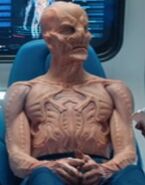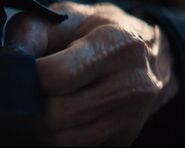(covers information from several alternate timelines)
 |
Warning! This page contains information regarding Star Trek: Discovery, and thus may contain spoilers.
|
Kelpiens were a humanoid species from Kaminar. They were one of two sentient species on the planet, along with the Ba'ul, with whom they had a complicated relationship. Empathy was a defining trait hardwired in the Kelpien DNA. (ST: "The Brightest Star"; DIS: "The Sound of Thunder", "An Obol for Charon")
Physiology[]

A medical scan of Captain Saru
Like other humanoid species in the galaxy, the evolution of Kelpiens was influenced by the Progenitors. (DIS: "Red Directive")
Kelpiens had a tall, lanky build, brownish orange skin, and no head hair, although males at least could grow facial hair at an advanced age. (DIS: "Su'Kal") Tendril-like threat ganglia splayed out from the back of a Kelpien's head when they sensed danger. Female Kelpiens typically exhibited smoother skin than males.
The species map on Kaminar did not have food chains, but instead was a binary of predator or prey. Kelpiens were the latter, and as such were biologically determined with heightened senses, and a hyper-vigilance to detect approaching danger in order to flee from it. This had been honed to the point of essentially a sixth-sense warning that a situation was dangerous – as Saru put it, the ability "to sense the coming of death." (DIS: "The Vulcan Hello", "Choose Your Pain") Besides having more developed senses, Kelpiens had exceptional physical strength and stamina relative to Humans: Kelpiens pursued by apex predators had exceeded speeds of eighty kilometers per hour. (DIS: "Si Vis Pacem, Para Bellum")
Kelpiens possessed visual, auditory, and tactile receptors more acute than those of Humans. They had a larger optical window than Humans and could see a far wider range of the electromagnetic spectrum, including in the ultraviolet. They could also see heat signatures. They could sense predators from as much as ten kilometers. (DIS: "Si Vis Pacem, Para Bellum", "Brother", "An Obol for Charon", "Project Daedalus")
At some point in their life cycle, Kelpiens would undergo a a physiological process called the vahar'ai. It was considered unique to their species and they interpreted it as a terminal condition signaling that they were ready to be culled for slaughter by the Ba'ul. It was extremely painful, and Kelpiens undergoing the vahar'ai were expected to present themselves for culling, which was said to make the pain go away. The alternative was believed to be madness. In fact, vahar'ai was a temporary condition that ended with the ganglia detaching, after which vital signs returned to normal. (DIS: "An Obol for Charon"; ST: "The Brightest Star")
After undergoing vahar'ai, the Kelpien's excessive fear responses appeared to be suppressed; Saru in particular showed a more confrontational nature. This was followed by the development of new keratin-based structures in the cartilage previously housing the threat ganglia, new organs from which a Kelpien could forcibly expel (or "shoot") spines (see dart) which grew from them; these structures extended outward in the same manner as the old threat ganglia in moments of great stress. Long ago in their planet's history, post-vahar'ai "evolved" Kelpiens nearly drove the Ba'ul to extinction before the Ba'ul subjugated them. (DIS: "The Sound of Thunder")
Female Kelpiens developed red spots on their foreheads when they were pregnant. To an uninformed eye, this could be mistaken for radiation burns.
Kelpiens appeared to be long-lived; one, Su'Kal, was about 124 years old as of 3189, and didn't display any signs of old age (whereas a hologram of a Kelpien of advanced age looked noticably old). One of the holograms cryptically stated Su'Kal had been “altered” to ensure his survival, so it is possible his longevity is unusual for Kelpiens and was the result of genetic engineering. (DIS: "Su'Kal")
History[]
Early history[]
The Kelpien species as a whole was at a pre-warp technological level as of 2257. Several hundred years before the 23rd century, Kelpiens who had undergone vahar'ai fought against the Ba'ul, driving them almost to extinction. The Ba'ul retaliated using more advanced technology however, subjugating the Kelpiens and eventually integrated a technologically supported ideology into Kelpien society. This ideology, known to the Kelpiens as the "Great Balance", kept the Kelpiens subservient by teaching them that they were a prey species for the Ba'ul. Kelpiens were monitored by pylons installed by the Ba'ul, which they called the Watchful Eye. (DIS: "The Sound of Thunder")
Kelpien society was thereafter shaped by the fact that they were essentially farmed as livestock by the Ba'ul. Kelpiens who underwent vahar'ai would voluntarily submit to Harvesting by the Ba'ul. More advanced technology could occasionally fall off of starships onto Kaminar's surface, where Kelpien custom dictated that it should be disposed of. (ST: "The Brightest Star")
Saru and the USS Discovery[]
The first Kelpien known to have achieved contact with greater galactic society was Saru, a 23rd century Kelpien who salvaged an abandoned Ba'ul communications array and made contact with the Federation Starfleet. Retrieved from Kaminar by the USS Archimedes, Saru was granted refugee status by the Federation on the understanding that the remainder of his species would remain subject to the Prime Directive. Saru soon decided to join Starfleet and was decorated with the Starfleet Medal of Honor for his actions aboard the USS Discovery in the Federation-Klingon War. Throughout his service, Saru kept detailed personal logs in the hope that when General Order 1 no longer applied to his species, they would know that a journey like his was possible. (ST: "The Brightest Star"; DIS: "Will You Take My Hand?", "An Obol for Charon")
In 2257, following an encounter with a spacefaring sphere-like lifeform, Saru underwent vahar'ai and survived, an unexpected experience which left him feeling empowered, and full of questions about the implications for both his race and planet. (DIS: "An Obol for Charon")
Saru returned to Kaminar later that year when the USS Discovery followed a red burst to Kaminar's star system. Returning to his ancestral village, Saru revealed to his sister, the priest Siranna, that Kelpien beliefs about vahar'ai were false. Both were kidnapped by the Ba'ul out of paranoia that revealing the truth of the "Great Balance" would once again result in the Ba'ul being driven to the point of extinction. With the aid of Discovery, Saru used Ba'ul technology to broadcast the same frequencies from the sphere that had triggered his own vahar'ai across Kaminar. Over 60% of the Kelpien population underwent vahar'ai, breaking the concept of the Great Balance.
The Ba'ul made a last-ditch attempt to commit genocide against the Kelpiens via the pylons. This was halted by the being known only as the Red Angel, which was witnessed by Saru and contributed significantly to Starfleet's understanding of the apparition. Following the incident, Saru expressed his belief to Siranna that the Kelpiens could move beyond their past animosity with the Ba'ul. (DIS: "The Sound of Thunder")
In early 2258, Siranna and other Kelpiens assisted Discovery and the USS Enterprise against Control in the Battle near Xahea, piloting Ba'ul fighters. (DIS: "Such Sweet Sorrow, Part 2")
The Federation[]
By the mid-31st century, the Kelpiens and Ba'ul had formed an Alliance and joined the Federation.
In 3064, the KSF Khi'eth, a Kelpien research vessel, crashed on Theta Zeta while charting a dilithium nursery in the Verubin Nebula. Five years later, Su'Kal, a child born to Dr. Issa among the wreckage, witnessed the death of his mother by radiation poisoning and screamed in horror. Because his genes had mutated to interact with the planet's dilithium in unique ways, and dilithium had a subspace component, this scream unleashed the Burn across the galaxy without his knowledge.
Su'Kal was finally rescued by the USS Discovery in 3189, and taken home to Kaminar. (DIS: "Su'Kal", "That Hope Is You, Part 2")
Society[]

Kelpiens farming on Kaminar
Until they became warp-capable, the Kelpien way of life had always been oriented toward death, and their role as prey to the Ba'ul. They were hunted, bred, and farmed (like Humans' livestock of old) by a species known as the Ba'ul. (DIS: "The Vulcan Hello", "An Obol for Charon"; ST: "The Brightest Star")

The culling ritual
Believing their role as a prey species to be part of the "Great Balance of Kaminar", Kelpiens were expected to offer their lives to sustain the Ba'ul after reaching vahar'ai. These harvests consisted of the chosen Kelpiens kneeling in a circle of stones beneath the Ba'ul ship, awaiting a bright light, and their ultimate disappearance. Priests explained how this sacrifice tied into the great balance, as well as an entity called the Watchful Eye, which was said to be in the sky. They reacted angrily to critical inquiries. (ST: "The Brightest Star")

Villagers on Kaminar
While Kelpien priests claimed this sacrifice allowed the others to live in "peace and comfort," according to Saru, Kelpiens lived in a constant state of fear from the moment of birth. Due to being a prey species, Kelpiens tended to prudently avoid risk or dangerous situations, giving them a reputation as being somewhat cowardly. When faced with a novel situation, their default assumption was typically to consider that it might be hostile – i.e., if it was unknown what had destroyed a interstellar relay, and it could plausibly have just been destroyed by an asteroid impact, a Kelpien would first assume that it was hostile action by a nearby threat, until proven otherwise. This did not mean, however, that Kelpiens would enter a fit of panic when faced with danger; rather, when faced with a fight-or-flight situation, they would calmly insist that flight was the wiser course of action. (DIS: "The Vulcan Hello"; ST: "The Brightest Star")
Kelpiens lived in packs, and occupied hut-like houses which included elements that emitted a yellow-orange light. Candles were also used for light. Fire was also used, by day and by night. They harvested flowers and a type of kelp-like aquatic plant, the latter with nets which were stitched using needles. Food was eaten using implements and bowls. They possessed a spoken and written language. Entertainment included a game with what looked like dice. (ST: "The Brightest Star")
Kelpiens were few in number. (DIS: "Context Is for Kings")

Kelpien slaves in the mirror universe
In the mirror universe, the species was both slave and livestock to the Terran Empire. Slaves, not permitted names, were stationed aboard Terran starships like the ISS Shenzhou, to serve the ship's captain. Kelpien entrails were dined on; their ganglia were particularly prized. (DIS: "The Wolf Inside", "Vaulting Ambition", "The War Without, The War Within", "Terra Firma, Part 1")
List of Kelpiens[]
Appendices[]
Appearances[]
A list of all appearances of Kelpiens (excluding the regular appearances of Saru).
Background information[]
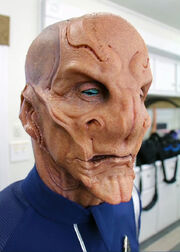
An early image of Kelpien Starfleet officer Saru, with Doug Jones wearing squinted contact lenses
The portrayal of the Kelpiens was originated by a collaboration between the writing staff of Star Trek: Discovery and Saru actor Doug Jones. [2] The opportunity to develop a new species was extremely exciting for Jones. He was glad he didn't have to play an already established species, because doing so would have had some pressure that, if he didn't get the portrayal right, Star Trek's fan base would have hated him. By contrast, he said, "This is like, 'Well, no one is going to know if I'm getting it right or wrong because, it's starting right here!'" [3] Jones elaborated, "To be given a new species, it's like, 'Okay, well I don't have that history pressure to bring forward, but now I have to start history today and move it forward from here,' so that brings a responsibility with it. I'm not gonna say it's a pressure, but it's a responsibility, for sure, to help make the Kelpiens… something memorable, something lovable… something heroic, in a way. Something that adds the right spice to the Starfleet Federation." ("Discovering Discovery: The Concepts and Casting of Star Trek: Discovery", DIS Season 1 DVD & Blu-ray special features) Jones also felt that the responsibility of establishing the Kelpiens was somewhat "daunting," because he wanted to do so in a way that was "right" and could be "emulated in later incarnations down the road through someone else." [4]
Doug Jones likened the Kelpiens to gazelles, saying that was "the best analogy in nature." He remarked, "We have our moments where we're chewing on something green and at peace." However, Jones also pointed out that Saru's people were meanwhile ever aware (by necessity) of danger, the actor comparing the species that hunts them to lions. [5]
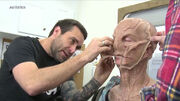
Doug Jones being turned into Saru
As originally conceived, Saru was to have had ten eyes and a triangle-shaped head. DIS writing staffer Bo Yeon Kim did a sketch of how she imagined him. (AT: "What's Past Is Prologue") Doug Jones was to have played only the lower half of Saru's face; the upper half was meant to be entirely represented using CGI and feature multiple eyes. However, the production staff realized that this plan would be unachievable, as it would require literally every shot in which Saru appeared to be a visual effects shot. The Kelpien makeup scheme proceeded to go through many different design phases. ("Creature Comforts", DIS Season 1 DVD & Blu-ray special features) It was designed by Neville Page. [6]
Whereas the original Star Trek shows including Star Trek: Deep Space Nine and Star Trek: Voyager had not had access to silicone and would have used foam latex instead of it, the Kelpien makeup scheme could make use of silicone. However, an early change to the sculpting procedure related to the fact that, when the makeup design was initially sculpted, it included a silicone prosthetic cowl covering that extended around the mouth and over the chin. At the behest of Makeup Effects Department Head James MacKinnon, the chin and lip areas were instead sculpted as separate prosthetic pieces. MacKinnon requested these changes in an attempt to help Doug Jones wear the makeup and emote through it, as having them be separate appliances would allow him more facial expressiveness. ("Creature Comforts", DIS Season 1 DVD & Blu-ray special features)
Ultimately, the Kelpien makeup primarily consisted not only of a silicone prosthetic cowl covering, the central facial appliance, as well as separate lower jaw and lower lip pieces but also prosthetic gloves that were used to modify the hands. (AT: "Context Is for Kings" – "Becoming Saru") During series production, applying the makeup to Doug Jones was supervised by James MacKinnon. He and another member of the DIS makeup staff mixed up a fifty-fifty version of Skin Tite, a slimy silicon-based adhesive, which they then slathered directly onto Jones' head before putting the main prosthetic on him. Rather than being glued to his head, the prosthetic could be removed like a sock after filming. The adhesive saved a huge amount of time, because gluing the prosthetic to the actor's head would be a bit slower and make removal of the appliance somewhat more difficult. However, glue was used to attach the facial appliance, so that it would have more adhesion and could be more expressive. Since the prosthetic covered Doug Jones' nose, the makeup department channeled air holes through the appliance to help him breathe more easily while wearing it. After the glue was brushed onto the center of the actor's face and the facial appliances were attached, spray-paint was used to blend the various pieces into each other as well as to match the coloration of the actor's skin around his eyes with the color tone of the appliances. ("Creature Comforts", DIS Season 1 DVD & Blu-ray special features)
The Kelpien makeup scheme ultimately included only one digitally enhanced component (the threat ganglia) and no mechanically enhanced parts. "Nothing else has to be mechanically enhanced," Jones clarified. "There's no servos, there's no joysticks, there's nothing that needs to be puppeteered or CG enhanced, except for the threat ganglia […] This is a [real] gift to the budget, to not have to use that much CG." The absence of CGI enhancement accentuated the importance of the actor's performance in how the alien was portrayed. [7] According to Star Trek author David Mack, the color of Kelpien eyes was added in post-production (at least for Saru's first couple of appearances) and wasn't visible in the initial set photography. [8]
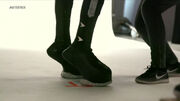
The Kelpien boots
The depiction of the species was influenced by Doug Jones devising Saru's physicality, such as the actor deciding how the character would stand, walk, and move his hands. For example, Jones decided Saru would walk "very much like a supermodel" and have hand gestures which he described as "very fluid" and "very much like an animal." [9] Jones found developing the look and physicality of the species was "really fun." [10] This physicality was enhanced by the use of special boots which lacked a heel, putting Jones up on his toes and adding an additional five inches to his height. This had the effect of changing Jones' center of balance, leading him to develop the "supermodel" walk. (AT: "Context Is for Kings" – "Becoming Saru") In fact, according to Jones, they were meant to suggest that a hoof was inside. (AT: "The Butcher's Knife Cares Not for the Lamb's Cry") He also suggested that the Kelpiens were "adept at land and in water," such that the physique of one of the Kelpiens, for example, included underwater capabilities. ("Creature Comforts", DIS Season 1 DVD and Blu-ray special features)
According to Doug Jones, no other members of the species apart from Saru had served as a Starfleet officer prior to him doing so. ([11]; AT: "Context Is for Kings" – "Becoming Saru") Jones is unsure but curious about what happened to this species after the events of Star Trek: Discovery. "I don't know if it can live on after this series because this is 10 years before The Original Series, so we'll see. It will be interesting to see what happens […] because, if this species never showed up anywhere after this in the timeline, the question remains, 'What happened to the Kelpiens?'" [12]
Apocrypha[]
According to the novel Desperate Hours by David Mack, Kelpiens were from a world known as "Kelpia". The novel suggested that they spent much of their time living underground, having been driven there "by the coming of the t'rrask" and that Saru was rescued from the world by Starfleet officers.
The novel The Dark Veil has a female Kelpien named Kono serving as a security officer aboard the USS Titan.



